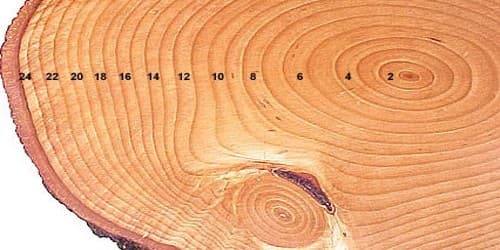Determination of age of Plants:
There are a number of ways the age of a tree can be calculated, depending on whether the tree is alive (and standing) or dead. Generally, the number of rings gives an overall age of the plant.
Every year springwood and autumn wood combinedly form an annual ring in the plant body. Such an annual ring is formed every year. Thus, by counting the total number of annual rings present in a plant body, an approximate age can be calculated.
Radiocarbon dating has been used to estimate the age of plants, but there are difficulties. At best, radiocarbon dating provides inference about the age of a plant but makes assumptions about the consistency of conditions and health in projecting out from the limited data.
For dead plants (fossils), carbon dating is the generally used technique, where the amount of carbon-14 remaining in the fossil gives a perfect approximation of its age. As mentioned, this method is used for fossils.
For a recently dead tree, you can plainly count the number of tree rings. Rings are developed at the rate of one per year, and a count of the rings will straight tell you its age.
Remember that, to calculate the age of a plant, one needs to focus on xylem and phloem. They are the tissues that transport water and nutrients in a plant, thus generating “rings” that grow from the center outer in the stem or trunk.
















